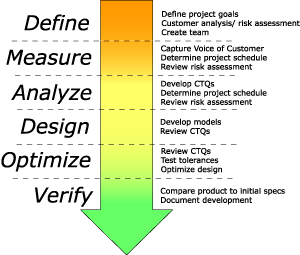Six Sigma is a system of practices originally developed by Motorola to systematically improve processes by eliminating defects. Defects are defined as units that are not members of the intended population. Since it was originally developed, Six Sigma has become an element of many Total Quality Management (TQM) initiatives.
The process was pioneered by Bill Smith at Motorola in 1986 and was originally defined as a metric for measuring defects and improving quality, and a methodology to reduce defect levels below 3.4 defects per (one) million opportunities (DPMO).
Six Sigma is a registered service mark and trademark of Motorola, Inc. Motorola has reported over US$17 billion in savings from Six Sigma as of 2006.
In addition to Motorola, companies which also adopted Six Sigma methodologies early-on and continue to practice it today include Bank of America, Caterpillar, Honeywell International (previously known as Allied Signal), Raytheon, Merrill Lynch and General Electric (introduced by Jack Welch).
Recently Six Sigma has been integrated with the TRIZ methodology for problem solving and product design.
The process was pioneered by Bill Smith at Motorola in 1986 and was originally defined as a metric for measuring defects and improving quality, and a methodology to reduce defect levels below 3.4 defects per (one) million opportunities (DPMO).
Six Sigma is a registered service mark and trademark of Motorola, Inc. Motorola has reported over US$17 billion in savings from Six Sigma as of 2006.
In addition to Motorola, companies which also adopted Six Sigma methodologies early-on and continue to practice it today include Bank of America, Caterpillar, Honeywell International (previously known as Allied Signal), Raytheon, Merrill Lynch and General Electric (introduced by Jack Welch).
Recently Six Sigma has been integrated with the TRIZ methodology for problem solving and product design.



